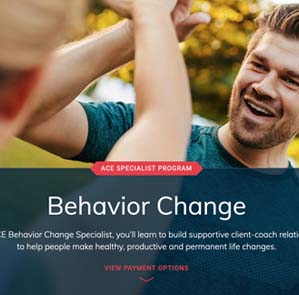
We all have someone in our lives—whether it’s a family member, friend or client—who has been told by a doctor that they need to lose a substantial amount of weight for one reason or another. It might be so that they can safely undergo a potentially life-saving surgery, prevent prediabetes from progressing to type 2 diabetes or even prevent a worsening disease or illness from taking their life. And then, for reasons their friends and loved ones find impossible to comprehend, they fail to lose weight or even continue to gain weight in the face of such dire consequences.
How can fear of a dramatically reduced quality of life, or even death, not be enough to trigger meaningful behavior change?
Because it’s hard.
Lifestyle change, whether it’s to lose weight, quit smoking, get better sleep or achieve any number of health-related goals, requires ongoing commitment and an ability to change current behaviors to achieve far-off goals. And if the goals are extreme and far into the future, as they typically will be for people trying to make potentially life-saving changes, that becomes exponentially more difficult.
Consider someone who needs to lose 100 or more pounds to qualify for surgery. They likely find it painful to walk, probably don’t know where to begin when it comes to eating a healthy diet and have developed a lifetime of negative coping and stress-management strategies that got them to where they are today. Then, a doctor tells them to lose weight and the people in their lives don’t understand why they don’t immediately change every aspect of their lifestyle. In essence, these individuals—who may turn to comfort foods, sedentary behavior, cigarette smoking or any number of unhealthy behaviors to manage their stress—have been hit with the ultimate stress bomb that will trigger all of those negative coping mechanisms and then they’re told to change their ways and “go lose weight.”
Unfortunately, while fear may be enough to initiate a newfound motivation to change, it doesn’t increase a person’s ability to do so. Behavior change requires a complex interplay of motivation, strategies, skills and support systems in order to be successful. The initial burst of motivation—“I’m going to change my life starting today”—will only carry a person so far, and unfortunately, probably not very far at all.
“Knowledge doesn’t equal behavior change,” explains Erin Nitschke, EdD, NSCA-CPT, an exercise science professor at Laramie County Community College in Wyoming. “It’s not so much that they’re unwilling to take the action. It’s more related to the fact that they don’t know where to begin.” Many clients who are in this type of dire situation will come to you after being told to do so by a doctor, so their motivation is almost entirely extrinsic. A doctor may have told them, “You need to do this or else…,” but there hasn’t been any additional coaching in how to make the changes needed.
“Our brains are designed to prioritize immediate threats and opportunities over long-term ones,” explains Jonathan Ross, creator of Funtensity, author of the book Abs Revealed and two-time Personal Trainer of the Year award winner (ACE and IDEA). “In the realm of lifestyle choices leading to healthful or unhealthful outcomes, the timeline is typically too long on the negatives.” In other words, an understanding that obesity, diabetes or heart disease will kill you eventually isn’t enough of an immediate threat to fuel ongoing behavior change.
There is another factor at play here, says Dr. Nitschke. People who are facing dire consequences due to their weight, for example, often feel they’ve gone too far to reverse the trend and that the amount of work in front of them is insurmountable. It can be so overwhelming that a client may want to quit before they even get started. Clients often need to be reminded that they didn’t get where they are overnight, and that they’re not going to get back overnight, either.
Another possibility is that a client may feel they need to flip a switch and change everything at once and may be resistant to the idea of starting slowly and changing one habit at a time. In such cases, you can talk about the consequences of going too hard too fast, such as potential burnout or injury. Also, ask your clients, “How realistic is it that you’re going to make and then stick with all of those changes at once?” That approach is highly unlikely to be effective, even in the best of circumstances.
“An unpopular truth of health,” says Dr. Nitschke, “is that progress takes time.”
What does the research say about the effectiveness of “scare tactics”?
Researchers investigating the effectiveness of fear as a motivator for change have looked at everything from driving behavior to alcohol use. The findings of these and other studies and meta-analyses have been inconsistent and sometimes conflicting, but there are some recognizable trends:
- When looking at driver behavior and safety, researchers found that threat-based road safety campaigns increased fear levels, but did not change driver behavior.
- A study into alcohol use among young people investigated whether visiting a hospital trauma center might alter behavior and found that small changes were seen immediately after the intervention, but that the effects had effectively disappeared just a few months later.
- The authors of a study into alternatives to fear-based approaches to behavior change state that a person’s level of self-efficacy in terms of changing the targeted behavior strongly influences their behavioral response to fear. In fact, those with low self-efficacy may become defensive, actively avoid the messaging and deny their risk.
- A meta-analysis found that fear appeals are effective at positively influencing a person’s attitude, intentions and behaviors. However, this may not hold true for long-term lifestyle change, as the researchers found that fear appears to be most effective for one-time actions rather than repeated behaviors.
What these studies reveal is that while fear can help make someone aware of a risk, it doesn’t appear to be an effective long-term driver of behavior change. Of course, clients who are at high risk of disease or even death are likely fully aware of the risks of their current lifestyle or they wouldn’t have sought out your help in the first place, so reinforcing that fear when you first meet a new client is probably not necessary, which begs the question…
Is there a place for “scare tactics” in the health and fitness industry?
“Of course there is,” says Ross. But these tactics must be used strategically.
Ross tells the story of a client with morbid obesity, who had accepted that he was headed in the wrong direction and wanted to be in a better place. Unfortunately, he was having trouble performing his new behaviors consistently. One day, Ross asked him to describe how his body felt, what his joints felt like and what his energy levels were like that day. “To paraphrase his response in a single word: ‘Terrible,’” says Ross. “I replied, ‘If you fail to begin making consistent positive health changes, today is as good as you will ever feel.’”
This was enough to inspire this client. He knew what “bad” feels like, Ross explains, so the notion of feeling “worse” was enough to motivate him to consistent action.
Dr. Nitschke agrees that there is a place in the profession for scare tactics—she prefers to call them “reality checks”—but agrees with Ross that you need to be mindful of which clients you take this approach with, as well where you are in that relationship. For example, early in the professional–client relationship, you might ask a client to envision the best version of themself and then ask questions like, “How do you feel?” and “What are you doing?” in that vision. Later, after you have established a solid rapport with that client, a time may arise when they are struggling to maintain their lifestyle changes, at which point you might ask the opposite question: “If you don’t change your current behavior, how does that vision of your future change? What things won’t you be able to achieve? What might you miss out on?”
“This can become a very frank conversation about the differences between where the client says they want to go and where their current behaviors might take them,” says Dr. Nitschke.
These conversations can help clients who need to make major changes to their behavior to attain long-term objectives understand whether their current habits or behaviors are supporting those goals. But again, you have to use motivational intelligence to decide whether a particular client is the right fit for this approach at that particular moment in time. Otherwise, you run a real risk of driving someone away right when they need you most.
Of course, emphasizing the benefits of physical activity, healthy eating or other lifestyle behaviors and remaining endlessly positive doesn’t always work, either. As Ross explains, “The benefits of physical activity are almost meaningless to people the way we typically present them because they are not emotionally relevant. They are rational, boring and abstract.”
Ross offers statements such as “Physical activity can lower blood pressure or improve flexibility or enhance endurance” as good examples. “So what?” he asks, saying that those are not what give meaning to people’s lives. Instead, he suggests we highlight travel and fun experiences with loved ones as things that actually motivate people to want to be active and develop a capable body.
Ross also highlights the risk of being relentlessly positive with clients, as that is not always the right approach and can be off-putting when someone needs a dose of reality or is feeling stressed or worried about their situation. Imagine telling someone you trust (like a health coach or exercise professional) about some very real fears about your personal health and them responding with an attitude of sunshine and rainbows—you’d likely feel that person wasn’t listening or didn’t care.
“Pretending that we need to present a positive face to the world at all times ignores the reality of light and dark, sunshine and rain, and all of the contrasts that are part of the human experience,” reminds Ross.
So, the challenge is to strike the appropriate balance between positivity and “scare tactics” and choose your moments wisely when you use negativity to motivate clients. A fear of death or worsening health or well-being may be enough to get someone started but it is a terrible motivator when it comes to sustainable action.
In Conclusion
When you first meet with a new client who has a significant health risk (or an existing client who has received a new diagnosis), a good first step might be to ask what the client knows about their condition:
“So, I understand that you were recently told that you have hypertension. What do you know about this condition? What did your physician share with you?”
Then you might ask:
“What do you understand about the risks vs. the benefits of behavior change when it comes to hypertension? What aspects of your condition are you in control of or do you think you can impact through behavior change?”
An open and honest conversation allows your client to tell you their own understanding of their condition and any fears that stem from that knowledge. You likely won’t need to tell them the risks or be a harbinger of doom in this situation. Remember, fear is a motivator, but only to a point, so it’s best to use it sparingly and strategically.
One final take-away message: Give clients and loved ones some grace and understanding when they receive dire or alarming news from a healthcare practitioner. Their fear, frustration and lack of comprehension about why it’s so difficult to change their behaviors almost certainly outweigh yours. Scaring or upsetting them further isn’t the best response. Instead, become a part of their support system and try to help and empower them as they make small, sustainable changes that may alter the course of their life, or even save it.
Expand Your Knowledge
 |
This program will help you familiarize yourself with common obstacles to achieving healthy behavior change and teach you how to help clients find their own path to a more fulfilling lifestyle. You will learn strategies, such as motivational interviewing and setting SMART goals, to help clients increase energy, prevent disease and develop healthier habits.
|
 |
Designed for health coaches, exercise professionals and healthcare professionals, this interactive course provides the core coaching competencies and communication techniques you need to practice and refine your behavior change coaching skills for the most effective results.
|
 |
Effect and inspire positive lifestyle change within your clients by applying behavior change strategies. Whether you are coaching clients in chronic pain or stress management, the Improving Wellness Through Behavior Change course bundle has you covered. Learn the latest techniques and strategies to work more effectively with your clients so they can establish healthy habits that last a lifetime.
|





 by
by 





